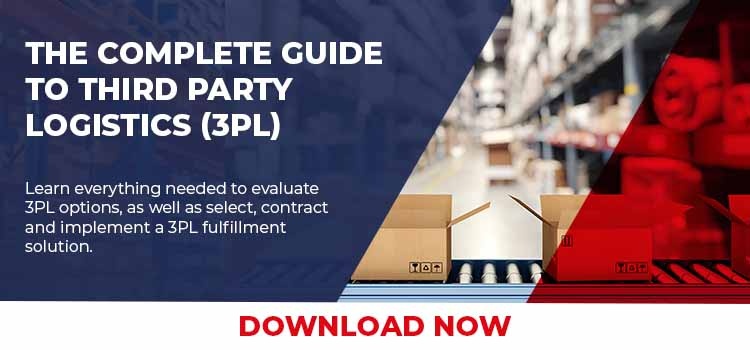After months of working with prospective 3PL vendors to support your supply chain, you likely received hundreds of pages of documentation and verbal promises. Once you have determined your preferred 3PL partner, it is time to begin to negotiate the contract.
All of the critical documentation from the sales process is important to capture in a 3PL agreement. This step is critical to protecting your business. In this final phase, you will want to have two parties review the agreement, the first being your attorney.
Your attorney will provide you legal advice to protect your business, do no skip this review for the sake of just moving ahead.
Secondly, you will want to have a 3PL consultant analyze the contract language from a business perspective. This review will help you to understand if the 3PL contract meets industry standards and expectations.
A typical 3PL agreement will include:
- Statement of work (SOW) and the 3PL services you are contracting for.
- The standards of performance, or Service Level Agreements (SLAs).
- The pricing of all quoted services with the 3PL vendor.
- The payment terms and review periods for invoicing.
- And a host of legal clauses such as warranty/guarantees, limitation of liability and termination clauses, etc.
This checklist is designed to provide you with a high-level understanding of how many 3PL contracts are structured. Additionally, it provides recommendations for how and where to negotiate with 3PL fulfillment and logistic companies.
3PL contracts must be fair and balanced between he client and the vendor. Your goal, with your attorney’s input, is to find the balance. This article is not intended to provide legal counsel.
Negotiating a 3PL Contract
Typically, the process begins with a “master services agreement”, think of this as a 3PL contract template. These documents are typically the baseline developed by the vendors attorneys which can favor the vendor.
As you begin to finalize the contract, look at the deliverables, services, standards, and pricing. Validating that they meet your company’s objectives and requirements. Remember that services or service-level agreements discussed with the sales team are not enforceable if they are not in the contract.
You only need a good contract when you need a good contract. Meaning when you need enforcing services or standards to protect your business and customers is not the time to discover that you have a worthless contract. Do not just accept a 3PL agreement template without a review.
In most cases, 3PL contracts for fulfillment services are three years or longer. Ask these questions as you review any 3PL contract for your business:
- How will costs increase and be limited annually?
- How are 3PL contracts terminated by either party for non-performance or otherwise?
- What can you do to keep the service performance high?
Additions to the master services agreement are specific to each client and can specify the services provided and at what cost. It is not uncommon for 3PLs to supplement this with addendums to cover:
- The Statement of Work (SOW)
- Pricing for all services specified in the sales process.
- Standards for service levels.
- Client procedures and processes unique to your business.
- Project schedule, covering all tasks from IT to operations.
- IT changes, integrations and EDI needs that have been agreed upon in the sales process.
Addendums should be updated as the services, standards, and costs change. Both parties will want to execute the addendum reflecting the changes.
Negotiating a 3PL contract requires a combination of business sense and legal guidance. Below are the major terms, conditions, and issues we commonly encounter when assisting companies committing to a 3PL partner.

Read: 9 Considerations Vendors Evaluate in Negotiating Deals
3PL Statement of Work (SOW)
The SOW and contract summarize all of the selling materials and promises made by the vendor during the sales process into a relatively short document. If it’s an important promise, get it into the contract.
The SOW summarizes the services that you and the 3PL are contracting for. The SOW should work in concert with other sections of the contract, such as standards and pricing of services.
Here is a partial list of services that the Statement of Work may include:
- Advance shipping notices (ASNs) for inbound transportation of the product, time to receive and inspection for inventory to be available for sale.
- Inventory management and storage.
- Transportation services being offered by the vendor.
- Order fulfillment of ecommerce orders.
- Retail store replenishment orders.
- Outbound shipping all order types.
- Returns processing from customers.
- Kitting component inventory into products for sale.
- IT services ASN, order fulfillment, invoicing utilizing EDI, standard reporting and analysis.
Generally, the SOW outlines services at a higher level. You and your attorney have to judge how detailed the SOW needs to be for your company.
3PL Implementation Scheduling
Incorporate a detailed project schedule, detailing the onboarding in their distribution centers:
- Is the implementation plan provided sufficiently detailed or just a high level?
- Is it detailed enough you feel comfortable committing your company to it?
Spell out the client and 3PL responsibilities. Identify go live dates for receipt of first inbound product and for shipping for first customer orders. Most project plans will include only the tasks required by the vendor to support the logistics service quoted.
Read: How to Select the Best 3PL Vendor For Your Business
Term Length of 3PL Agreement
As stated, many agreements are for three years or longer. While it is a long time, think about this. Facilities only have a certain fixed capacity to store product, and to process a certain volume of orders.
It’s expensive and disruptive for both the client and the 3PL to move in and out of a facility. Long term agreements make sense if they are a win for both parties. A short-term contract may have higher front end cost to cover any material handling equipment needed by the vendor.
It is not uncommon to see optional 1 or 2 year renewal terms once the initial term length has passed.
3PL Price Increases
How does the agreement structure 3PL price increases over the term of the agreement? Generally, prices for services are guaranteed for a 12-month period. After this period, there is an annual cost escalator such as a set percent increase or an increase based on the Consumer Price Index (CPI).
A thorough contract identifies where the potential for price increase will happen with the 3PL.
3PL Service Level Agreements
The 3PL service level agreements and performance should be spelled out. Keep in mind, standards which are too tight can radically increase the price. Consider what penalties should be in place for failure to perform. If your demands are too extreme, you will probably not get acceptance by the vendor.
Some key standards are:
- Order fulfillment cut-off times for processing same day orders.
- Return processing, including customer credits and refurbishing.
- International orders shipping time, such as same day or next day.
- Error rates for order fulfillment.
- Inventory shrink allowance.
To keep 3PL service level agreements high, establish a short monthly recurring call between both companies’ senior management. Even though both parties talk every day, management doesn’t, and this will help keep service levels high.
Read: 11 Key Indicators to Keeping 3PL Service High
3PL Processing and Value Added Services Procedures
Are there specific procedures important in delivering the customer service you expect? If so, attach them to the agreement.
Some commonly requested procedures include:
- Standards for customer order appearance of shipping boxes. Typically, this might include shipments without excessive tape, proper box sizes, and gift boxing.
- Ensuring inventory is dust-free before it gets packed.
- Elaborate kitting instructions for gift baskets.

3PL Contract Termination and Renewals
A 3PL contract will identify the specific conditions the agreement can be terminated. Does the 3PL's performance to contractual standards, error rates, service levels and account management allow you to terminate the agreement? Consult your attorney and identify the specific conditions and language.
Agreements often have automatic renewal clauses. In these agreements, the contract renews unless the client notifies the 3PL of termination within a specified period of time before the end of the contract. Most commonly, this period is between 60 and 90 days.
Remember, it takes months to select a new 3PL and months to move your business elsewhere. Opening an internal fulfillment center takes 9 to 12 months to plan and open a fulfillment center. Make sure the termination language protects both parties and never terminate an agreement without a firm plan in place.
Agreements often specify payment of all invoices upon the termination of the contract by either party. Inventory can be held until invoices are paid, which can prevent a move.
Warranty of service
Putting your order fulfillment in the hands of an outside party is a big move. It is understandable that every company wants to have protection for their business. The standards section discussed earlier outlines your expectations for performance. Your attorney will need to advise you on warranty of service to protect your company.
Inventory
Remember that inventory is one of the largest balance sheet assets in retail and e-commerce businesses. Most agreements state that the inventory is purchased by the client for their use in selling to the customer.
The client carries insurance against loss and damage. The client also pays for transportation directly from the vendors, unless otherwise agreed upon with the client.
Some agreements have a Warehouseman’s Lien against the inventory for charges incurred in performing services. The 3PL may reserve all rights and remedies under applicable law.
The 3PL also has no responsibility for claims or warranties involved with the product.
Intellectual property
Early on the client and the 3PL should have signed a mutual non-disclosure agreement (NDA) to protect detailed discussion of the project and 3PL capabilities. Mutual means that the NDA equally protects both parties’ intellectual property.
The contract often has different wording from the earlier, standalone NDA. Decide with your attorney how to carry forward the original NDA’s provisions.
Agreements should define your intellectual property, including but not limited to:
- business plans
- forecasts
- product specifications, vendor name, and address files
- customer order, return, and contact files
- promotional calendars and brand and channel marketing techniques
- internal processes and copyright-protected materials
When in doubt, clearly label all of your company's copyrighted and confidential materials.
The 3PL’s intellectual property includes, but is not limited to:
- software vendor intellectual property protected by copyright through licenses granted to the 3PL or provided by suppliers, such as carrier shipping systems
- databases
- software tools
- any knowledge base
- any carrier rate tables
- 3PL internal sales plans
- other internal client processes
- promotional materials
- methodology in selling and installing
3PL IT Services and Reporting
There are three categories of IT services and corresponding charges.
- Agreed upon analysis and reports
These may be scheduled or on-demand analysis or reports which are part of the charges for the services. One thing that often gets overlooked is top management’s favorite reports. Minimize future charges by including in the contract either a corresponding report or the data access to generate a report quickly upon request.
Does the potential 3PL partner have a vendor portal for you to access your data and a report book of all the analysis and reporting available? Reference the report book. - New requests for reports and functions
These will be charged back to the client typically at several hundred dollars per hour. - Implementation charges
These functions include those that are part of the implementation or integrations to your systems and EDI requirements. Identify these costs and include them in the implementation costs.
3PL Invoice and Payment Terms
These are the categories of expenses you should expect:
- The implementation activities included with hours and fees, such as:
- on-site analysis
- training
- file conversion
- management meetings
- 3PL internal project management and meetings
- programming
- testing
- Activities charged back on as hourly charges or on a project basis - example kitting or cycle counting.
- Detail processing charges based on the services and pricing sections, such as picking.
- whether the implementation is a fixed fee or is billable by major activity, such as programming and testing
- whether the implementation costs are billed upfront or spread over time
There will be advances for fees which the 3PL will make on your behalf, including:
- postage (e.g. catalogs requests, collateral mailings, sample distribution)
- carrier shipping payment and freight surcharges
- packing supplies
- taxes and import fees
- document transmission
- communication
Is the advanced payment purely a pass-through or is it marked up (e.g. 5%)? Replenishment of these funds is generally payable upon receipt.
Some 3PLs invoice weekly; others monthly. What are the payment terms – upon receipt, Net 15 or Net 30 days after receipt of invoice? Are there late fees and interest charges? In extreme cases of slow payment, 3PL may reserve the right to stop processing and shipping until all payments are made.
Does the contract specify payment by check or electronic funds transfer?
Dispute Resolution of Invoicing
A client should reserve the right to audit and review invoices for their account. Some 3PL invoicing systems are very easy to understand and cross-reference transactions for services and rates, as well as hours worked by the activity.
Others are very difficult to clearly understand and may require 3PL assistance monthly. Generally, the client is required to pay the undisputed portion of the invoice and cannot hold back the entire invoice. What is the billing resolution process in your contract?
Filing Legal Claims and Governing Law
The agreement will specify the method of settling legal disputes, either through arbitration or the courts. Many companies use arbitration because arbitration has the full force of the law and it is less expensive. Because the 3PL is the seller, it has the choice of which state legal proceeding and arbitration are subject to and held in.
Inventory Shrink Allowance
Inventory losses can occur from paperwork problems, computer issues, processing errors, and theft. Many 3PL inventory systems and processes are fully barcoded and have high accuracy.
The agreement should have a shrinkage loss specified, typically up to 0.5% shrinkage. What this means is that the client will absorb the first 0.5% loss and the 3PL will absorb the costs over 0.5%. This is generally calculated on an annual timeframe based on actual cost. But, monthly inventory accuracy accountability, such as inventory audit trail of adjustments, will allow you to have a better handle on any inventory losses.
The 3PL is not responsible for the negligence of client, agents, or shipping companies in handling inventory. 
Business Forecasting
As your fulfillment partner, the 3PL needs to know what your annual order and receipt plans are, as well as any promotional plans and daily/weekly order projections. Some forms of marketing, like DRTV or infomercials, can generate high spikes in orders.
Other industries may experience holiday peaks that are 10 times higher than their average week. Keeping promotional plans and order levels projections are standard in most agreements. Generally, there is a rolling 13-week sales order forecast (financial quarter) so that the 3PL can plan staffing.
There often is a provision that if the actual is more than X% in error (e.g. 10%) of the forecast, then the 3PL has the right to do something in return. Consequences for inaccurate forecasts include:
- the 3PL not meeting standards during the error period
- charging overtime labor costs back to the client
- charging back a premium for services
In practice, there should be a weekly call to discuss promotions, anticipated orders, and inbound receipts. If there is a significant decline in processing volume, there may a remedy for the 3PL, such as proposing new pricing. It is the client’s responsibility to have on-site current literature and inserts at 3PL.
3PL Visits and Account Management
How much notice does the client have to give to visit the facility? The liaison for both the client and the 3PL are very key. Can either ask for the account manager to be replaced if there is justification?
Insurance Coverage
What insurance will each party keep in force during the agreement? What is their dollar coverage?
Typical insurances include:
- General Liability
- Employee Dishonesty and Fraudulent Acts
- Workmen’s Compensation
Hiring Employees
Agreements often include whether either party can hire each other’s employees. Is there a waiting period to hire after termination?
Independent Contractors
The 3PLs are independent contractors, not partners or joint venture partners unless otherwise specified.
Force Majeure
This is an area where you will want to consult your lawyer. Most agreements list out circumstances outside the 3PL’s control which prevent them from fulfilling the contract. Examples are acts of God, labor disputes, breakdown of facilities, government action, and weather.
Because of this clause, it is important to understand the 3PL’s disaster planning as part of the selection process. This includes any concurrent systems backup of data and other major potential failure points.
Indemnification
This is another area where your attorney knows best. Indemnification shifts the cost of a suit to another party. For example, 3PL will ask the client to bear the costs, including attorney’s fees, to protect its management and employees if the client is sued by a third party for something resulting from use of the client’s product. Exceptions may be if 3PL is found to be negligent or have willful misconduct.
Advertising
Agreements often give the 3PL the right to use the client’s business name in advertising, brochures, selling materials, trade show booths, and social media. Are there any stipulations you want to make about the use of your personal name, company name, or logo, such as usage is only allowed after successful implementation and Go Live?
Assignment
Can this contract be assigned to another company without the permission of the other party, such as in the event either company is acquired?
A Few Thoughts
Here are a few more things to consider about contracting with a 3PL:
- 3PLs often specialize in categories of products or services, such as apparel, pharma, cold storage, or vendor compliance to “big box” retailers to name a few. Generally, 3PLs will not accept restrictions on services - even to your competitors - because it restricts their business and it’s hard to define who is a direct competitor. If you don’t trust, don’t contract.
- Don’t overstate your sales forecast to make your company look more attractive to providers. Ultimately, you lose credibility and have to face higher pricing from lower volume, anyway.
- 3PL carrier shipping rates may be lower, but you have to be willing to advance the fees.
- Language regarding the warranty of service, guarantees, and damages are tricky. Rely on your attorney.
Summary
- Get the important 3PL promises regarding performance, pricing, and schedule in writing.
- Spend the time analyzing and planning the three years’ business proforma so that you don’t incur higher costs than expected.
- Negotiating the agreement takes time. Think out the consequences of various actions and potential problems. Review the agreement with all stakeholders, attorneys, and management.
- An experienced 3PL consultant working with you, your attorney and the 3PL will be beneficial and move the process along.

Note: This blog post may not use proper legal terminology and should NOT be considered legal advice as we are not attorneys. This knowledge comes from working with clients, their attorneys, and management to develop 3PL agreements that are fair to both parties and deliver the results the client companies are expecting.







SHARE